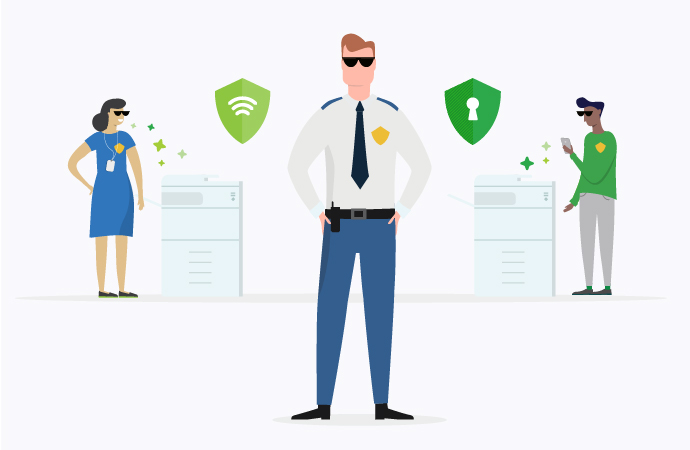Strong print security needs a strong security culture. In other words, data leakage prevention starts with your people. So while we’re the first to admit that our print management software can help secure your documents, we’ll also acknowledge that print security remains, at heart, a people problem.
But that’s good news, right? Technology won’t fix a people problem, but it can definitely help. As a print management company, we’ve seen tons of organizations around the world use our software, together with cultural change, to achieve big security wins. In this article, we’re going to run through data leakage prevention, and how to make print security second nature.
What is print security?
Print security can cover all sorts of things, from access control and print job auditing to encryption and intrusion detection, but ultimately it’s about protecting printed documents, and the machines that make them. The goal of print security is to control who can print what, and who has access to printed materials. Print security protects your files from unauthorized access, disclosure, alteration and theft.
Document leakage prevention is everyone’s business
The first thing to understand is that print security and document leakage prevention aren’t just the remit of the IT team, or your cybersecurity manager. These days, with high-profile data breaches becoming more and more common, print security is everyone’s business. And everyone’s responsibility. As a manager, it’s your job to make sure staff are informed of current threats and trained in good print security techniques. Print management software, like PaperCut, is really there to facilitate that process – not replace it.
How to build a strong print security culture
So how do you actually build a good print security culture? The trick is to start small. For most companies, the path to print security is taking incremental steps that make a difference in daily office life. Security-related solutions can help here, but the real secret sauce is combining security tech with cultural change
Let’s look at an example. A simple task, like having to sign into an office printer, could annoy or confuse a user if they don’t understand the benefit of it. But if you explain the environmental benefits, such as saving paper and toner, not to mention the security upside, you’ll have a much more compelling case for cultural change. And that helps staff buy in.
Five tips for building a print security culture
PaperCut has a whole range of print security features worth exploring, from secure print release to embedded software at the MFD . The thing is, a secure system is only as safe as the people using that system. So here are five ways to make print security and document leakage prevention second nature:
Security belongs to everyone – It’s tempting to assign network/printing security responsibility to an expert – usually someone sitting in IT – and hope the job will be done. But honestly, that’s how accidents happen. Roughly 88% of all data leaks are caused by simple human error. So successful cultural change has to involve more than just the overworked IT staff. In particular, it must include people that create and consume documents. That’s all of us!
Give users context – You want your users to be informed so they can build understanding and take ownership of their printing habits. Imagine if your staff really knew how many documents are printed each week. Minds blown, right? As people, we don’t tend to value risks until we learn the wider context: what’s at stake? How common is the danger? What are the consequences of a breach? Giving your users more context around your business’s printing habits will help them understand the risks of print security. And this comes back to training.
Recognise people who do the right thing – This is often the number one way to encourage a change in behavior – reward those who do the right thing! Shout them out in your company’s Slack channel. Offer a reward for those who catch a potential security issue. Recognise small steps in the right direction – give a quick monthly round-up on the number of users using secure print release, and offer training to anyone who doesn’t understand the software. PaperCut makes this sort of tracking easy: at a glance, you can quickly see how many print jobs are securely released.
Unity is strength – Don’t weaken your security effort by compartmentalizing each department. Security is only as strong as your weakest link. It doesn’t matter if you have an A-grade IT team if marketing and finance are printing unsecure documents all over the place. Document security should be seen as integral to overall cyber and building security; when you talk about one, talk about the others. That will help instill the message that print security is everyone’s responsibility.
Make document security fun – Security is serious, but it doesn’t need to be boring. Try gamifying the security message – who’s up for trivia? Offer prizes for users who get the right answers. Use real world examples of document leakage or cyber breach. Even share some of your own mistakes. Lastly, try combining security with a positive message. It’s not about enforcing rules and punishing people, it’s about building something: a safer workplace. In the case of document security, you could try talking up the environmental angle – safer printing is often less wasteful printing. That’s a win on both fronts!
If you want more in-depth info on print security and document leakage prevention, check out our Security Whitepaper . That’s a good place to start. You can also learn more about Secure Print Release and common security questions on our website.


